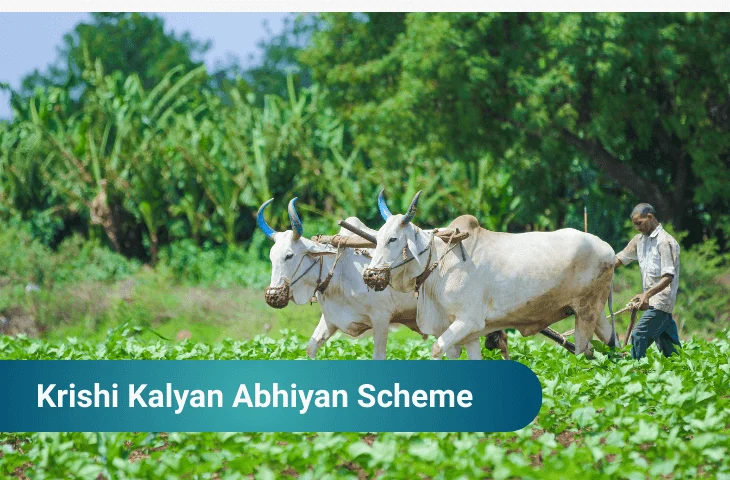Agriculture is the backbone of the Indian economy, and nearly half of India’s population is dependent on farming for livelihood. To improve the income of farmers and strengthen rural prosperity, the Government of India has launched several schemes. One such initiative is the Krishi Kalyan Abhiyan (KKA).
The scheme was launched in June 2018 by the Ministry of Agriculture and Farmers’ Welfare. The scheme was part of the government’s vision of doubling farmers’ income by 2022. It was implemented in aspirational districts identified by NITI Aayog, focusing on improving farming practices, livestock health, and farmers’ incomes through modern technologies, awareness campaigns, and training programs.
In this blog, we provide details to allow aspirants understand the objectives, features, and implementation of this scheme.
What is Krishi Kalyan Abhiyan?
The Krishi Kalyan Abhiyan (KKA) is a central government program launched in 2018 to improve farming methods, livestock health, and rural livelihoods. It aimed to bring modern practices to farmers in rural areas and promote sustainable agriculture.
It was designed to aid, assist, and advise farmers on the best agricultural practices, provide them with quality inputs, and introduce income-enhancement activities.
Why was the Krishi Kalyan Abhiyan Launched?
The main reason for launching the scheme was to address challenges faced by farmers in rural and underdeveloped districts. Many farmers had low productivity due to:
- Poor soil health
- Limited irrigation facilities
- Lack of awareness of modern technologies
- Insufficient livestock healthcare
- Limited access to quality seeds and plants
Check Out: Complete List of Important Schemes for NABARD Grade A Exam
Which Ministry Implements Krishi Kalyan Abhiyan?
The Ministry of Agriculture and Farmers’ Welfare is the nodal ministry for the scheme. Within the ministry, three major departments were actively involved:
- Department of Agriculture, Cooperation & Farmers’ Welfare (DAC&FW)
- Department of Animal Husbandry, Dairying & Fisheries (DAHD&F)
- Department of Agricultural Research and Education (DARE)
The Krishi Vigyan Kendras (KVKs), also known as Farm Science Centres, played a crucial role in implementation. They worked at the ground level, organizing training programs, demonstrations, and awareness camps.
Where was the Krishi Kalyan Abhiyan Implemented?
The scheme was targeted towards Aspirational Districts, which are districts identified by NITI Aayog as backward in terms of development indicators.
- The program was implemented in 25 villages in each aspirational district.
- Villages with a population of 1,000 or more were selected.
- If a district had fewer than 25 such villages, all eligible villages were covered.
In total, the scheme was implemented across 112 aspirational districts in Phase I, later expanded to 117 districts in Phase II.
Get ready to crack government job exams with leading educators
What were the Key Functions of Krishi Kalyan Abhiyan?
The functions and activities under the scheme were diverse and covered farming, livestock, irrigation, and training. Some of the key functions were:
| Category | Details |
| Soil Health Management | – Distribution of Soil Health Cards to farmers. – Promotion of balanced fertilizer use. |
| Livestock Health | – 100% vaccination for Foot and Mouth Disease (FMD) in bovines. – 100% vaccination for Peste des Petits Ruminants (PPR) in sheep and goats. |
| Artificial Insemination | – Coverage of artificial insemination to improve cattle breeds. |
| Input Distribution | – Distribution of mini-kits of pulses and oilseeds. – Distribution of horticulture, agro-forestry, and bamboo plants at subsidized rates. |
| Composting & Organic Farming | – Establishment of NADEP pits and vermi-compost units. |
| Modern Agricultural Practices | – Demonstrations on micro-irrigation. – Demonstrations on integrated cropping systems. |
| Training Programs | – Conducted by ICAR and KVKs. – Training in beekeeping, mushroom cultivation, and kitchen gardening. – Special focus on women farmers. |
What were the Phases of Krishi Kalyan Abhiyan?
The scheme was rolled out in three phases:
- Phase I (June 1 – August 15, 2018): Implemented in 112 aspirational districts.
- Phase II (October 2, 2018 – January 25, 2019): Expanded to 117 aspirational districts.
- Phase III (Planned): Included training of 17 lakh farmers in diversified farming practices.
What were the Results and Impact of Krishi Kalyan Abhiyan?
The scheme created a visible impact in rural areas:
- 1.1 million farmers trained in the first two phases.
- Over 5,000 field demonstrations conducted.
- Large-scale distribution of Soil Health Cards, mini-kits, and composting pits.
- Increased awareness about water conservation under Jal Shakti Abhiyan.
- Promotion of sustainable farming techniques.
How does Krishi Kalyan Abhiyan Link with Other Schemes?
The KKA was designed to work in coordination with other government schemes, such as:
- Pradhan Mantri Krishi Sinchayee Yojana (PMKSY) for irrigation.
- Soil Health Card Scheme for balanced fertilizer use.
- Pradhan Mantri Fasal Bima Yojana (PMFBY) for crop insurance.
- MGNREGA for the development of Gramin Haats and water conservation.
Also Check: List of Government Schemes of India
How is Krishi Kalyan Abhiyan Different from Other Government Schemes for Farmers?
The Krishi Kalyan Abhiyan (KKA) works mainly in aspirational districts to give farmers support in farming, livestock health, and training. On the other hand, schemes like PMKSY, PMFBY, and the Soil Health Card Scheme focus on irrigation, crop insurance, and soil management.
| Aspect | KKA (2018) | PMKSY (2015) | PMFBY (2016) | SHC (2015) |
| Ministry | Agriculture & Farmers’ Welfare | Agriculture + MoWR + MoRD | Agriculture & Farmers’ Welfare | Agriculture & Farmers’ Welfare |
| Focus | Farming + Livestock + Training | Irrigation & water use | Crop insurance | Soil testing & fertilizer use |
| Coverage | 112–117 Aspirational Districts | Pan-India | Pan-India | Pan-India |
| Beneficiaries | Farmers in 25 villages per district | Farmers needing irrigation | All farmers (loanee & non-loanee) | Farmers with landholdings |
| Key Features | Soil Health Cards, Vaccination (FMD/PPR), AI, Kits, Compost, Training (KVKs/ICAR) | “Har Khet Ko Pani”, Per Drop More Crop, Watershed | Low premium (2% Kharif, 1.5% Rabi, 5% commercial), Risk cover | Soil Health Cards every 2 yrs, Fertilizer advice |
| Unique Point | Works only in Aspirational Districts | Water efficiency focus | Insurance for crop loss | Soil quality improvement |
| Agencies | KVKs, ICAR | States, MoWR, NABARD | Insurance firms, Banks, State govts | State Agri Dept, Soil Labs |
Key Takeaways
| Aspect | Details |
| Launch Year | 2018 |
| Nodal Ministry | Ministry of Agriculture and Farmers’ Welfare |
| Coverage | Aspirational districts (112 in Phase I, 117 in Phase II) |
| Village Selection | 25 villages per district with 1,000+ population |
| Nodal Agency | Krishi Vigyan Kendras (KVKs) |
| Key Activities | Soil Health Cards, vaccinations, AI, mini-kits, plants, composting, training |
| Phases | Phase I (2018), Phase II (2018–19), Phase III (planned) |
| Impact | 1.1 million farmers trained, 5,000+ field demonstrations |
| Objective | Doubling farmers’ income by 2022 |
Also Read:
Questions on Krishi Kalyan Abhiyan
Q1. In which year was the Krishi Kalyan Abhiyan launched?
a) 2015
b) 2016
c) 2017
d) 2018
e) 2019
Answer: d) 2018
Q2. Which ministry implements the Krishi Kalyan Abhiyan?
a) Ministry of Rural Development
b) Ministry of Agriculture and Farmers’ Welfare
c) Ministry of Panchayati Raj
d) Ministry of Food Processing
e) Ministry of Jal Shakti
Answer: b) Ministry of Agriculture and Farmers’ Welfare
Q3. How many villages were covered in each district under KKA?
a) 10
b) 15
c) 20
d) 25
e) 30
Answer: d) 25
Q4. What is the role of Krishi Vigyan Kendras (KVKs) in KKA?
a) Monitoring only
b) Providing financial loans
c) Nodal agencies for implementation and training
d) Only soil testing
e) Insurance claims
Answer: c) Nodal agencies for implementation and training
Q5. Which disease is targeted for 100% vaccination in bovines under KKA?
a) Tuberculosis
b) FMD (Foot and Mouth Disease)
c) Anthrax
d) Rabies
e) Swine Flu
Answer: b) FMD (Foot and Mouth Disease)
Q6. Which of the following is NOT a component of KKA?
a) Soil Health Card distribution
b) Beekeeping training
c) Mushroom cultivation training
d) Crop Insurance distribution
e) Micro-irrigation demonstrations
Answer: d) Crop Insurance distribution
Q7. The aspirational districts were identified in consultation with which body?
a) Planning Commission
b) NABARD
c) NITI Aayog
d) RBI
e) State Governments only
Answer: c) NITI Aayog
Q8. How many farmers were trained in the first two phases of KKA?
a) 5 lakh
b) 7 lakh
c) 9 lakh
d) 11 lakh
e) 15 lakh
Answer: d) 11 lakh (1.1 million)
Q9. Which scheme supports Gramin Haat development under KKA?
a) PMGSY
b) PMFBY
c) MGNREGA
d) NFSA
e) RKVY
Answer: c) MGNREGA
Q10. What was the ultimate vision behind launching KKA?
a) Ensuring food security
b) Reducing imports
c) Doubling farmers’ income by 2022
d) Export promotion
e) Digital agriculture only
Answer: c) Doubling farmers’ income by 2022
- MISHTI Scheme, India’s Initiative to Restore Mangrove Ecosystems
- National Green Hydrogen Mission Features, Objectives, and Benefits
- Paramparagat Krishi Vikas Yojana, Transforming India’s Organic Farming
- Mission on Integrated Development of Horticulture NHM and HMNEH
- Swachh Bharat Mission, India’s Journey Towards Cleanliness and Hygiene
- SAGY, A Step Towards Holistic Development of Indian Villages

Hi, I’m Aditi. I work as a Content Writer at Oliveboard, where I have been simplifying exam-related content for the past 4 years. I create clear and easy-to-understand guides for JAIIB, CAIIB, and UGC exams. My work includes breaking down notifications, admit cards, and exam updates, as well as preparing study plans and subject-wise strategies.
My goal is to support working professionals in managing their exam preparation alongside a full-time job and to help them achieve career growth.
